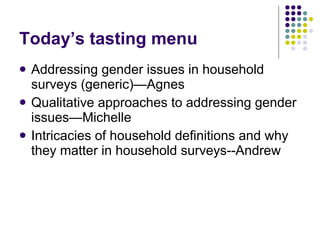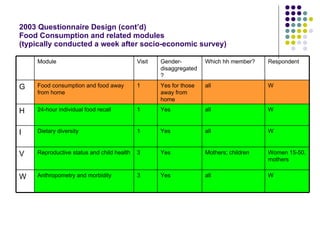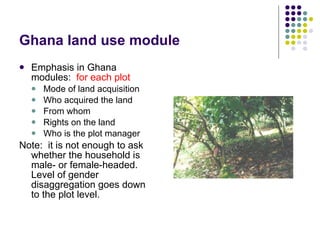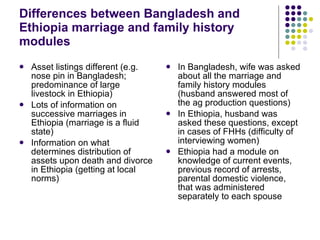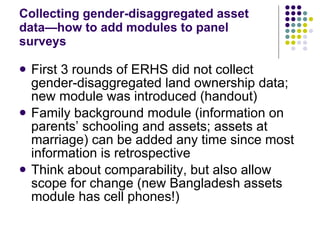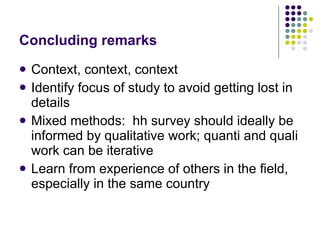Identifying gender issues in your research
- 1. Identifying Gender Issues in Your Research: No Cookie-Cutter Approaches Agnes R. Quisumbing International Food Policy Research Institute
- 2. Basics Gender is the socially constructed relationship between men and women Gender issues are very contextual ; since the definition of men’s and women’s roles is specific to space and time, gender divisions cannot be checked off from lists (even if checklists are popular in some places!) Thus, there is no cookie-cutter approach to addressing gender in your research.
- 3. Today’s tasting menu Addressing gender issues in household surveys (generic)—Agnes Qualitative approaches to addressing gender issues—Michelle Intricacies of household definitions and why they matter in household surveys--Andrew
- 4. Why look at gender in your research? Because you know that gender issues are important in your specific research setting, but are not really sure about the magnitude of impact on outcomes of interest Because you suspect gender issues might be important, but are not sure which issues are the most important Because you are curious!
- 5. The extent of your pre-existing knowledge will affect the design of your research If you are just curious, read the anthropological literature and other studies, to get some focus. Lack of focus is expensive! If you suspect that gender issues are important in a few key areas, read other studies, conduct qualitative work, before designing a survey If you know that gender issues are important and in which area, you can be more focused in questionnaire design. This still does not substitute for field work (field observations and pre-testing) and ideally, qualitative work before questionnaire design If you really want to learn more, strive for integrated qual and quant work
- 6. Caveats Doing a survey on gender issues is NOT the same as classifying the household as male- or female-headed Reasons behind female-headship vary a lot across countries and cultures; comparing a FHH in Bangladesh to one in Jamaica is like comparing…mangoes and pineapples A focus on headship may in fact detract the researcher from some of the more interesting dynamics that occur in MHHs It is not enough to take a module from one survey and implement it in another country with very different social and cultural conditions Example of women’s empowerment module: from Bangladesh to Mexico
- 7. Purpose of my presentation : To illustrate how questionnaire modules can be designed to look at key issues from a gender perspective To give examples of topics where data collection can be gender-disaggregated To show how the same basic question (say, control of land and assets) needs to be adapted to specific context, using survey modules on the same topic, but administered in different settings To discuss issues of survey implementation
- 8. This presentation draws from survey work done under MP17, on intrahousehold and gender issues, 1994-2002 Four high-concentration countries (Bangladesh, Guatemala, Ethiopia, South Africa) Eight supplemental studies countries
- 9. Where can we insert/modify modules to look at gender issues in a standard household survey? Let’s take a look at one of IFPRI’s recent surveys, the Bukidnon Panel Survey 2003 round (patterned after the 1984/85 agricultural commercialization and nutrition survey, discussed in Bouis and Haddad 1990) Typical module with gender-disaggregated info ALWAYS collected: purple cells Gender-disaggregated info SOMETIMES collected: orange cells Specialized module with gender-disaggregated info ALWAYS collected: green cells
- 10. 2003 Questionnaire Design Socio-economic modules Module Visit Gender-disaggregated information? About which hh member? Respondent A Roster—very important, since all Ids in subsequent modules will come from here 1 Yes All! H, W B Inheritance 1 Yes Children who are married, or living away H, W C Migration 1 Yes Children living away H, W D Education-short 1 Yes Coresident children of orig W E Education-long 1 Yes Orig: coresident child; split child & spouse Self (kid) F Shocks 1 No Since 1984 or since leaving parents’ house H, W J Nonfood consumption 1 Partly (clothing, footwear) All W
- 11. 2003 Questionnaire Design Socio-economic modules (cont’d) Module Visit Gender-disaggregated information? Which hh member? Respondent K Parcels 2 Yes ID of person who acquired the plot H L Production Record 2 Yes ID of worker H M Major Crop Production 2 No H N Agricultural Wage Labor 2 Yes ID of laborer H O Other Income 2 Yes ID of people with other incomes, businesses, ID of people sending and receiving remittances H, W P Backyard Production 2 No W
- 12. 2003 Questionnaire Design Socio-economic modules (cont’d) Module Visit Gender-disaggregated? Which hh member? Respondent Q Assets 3 No H or W R Social Capital 3 Yes ID of group member H or W S Savings 3 Yes ID of account owner H T Credit 3 Yes ID of borrower H, W U Lending 3 Potentially ID of borrower H
- 13. 2003 Questionnaire Design (cont’d) Food Consumption and related modules (typically conducted a week after socio-economic survey) Module Visit Gender-disaggregated? Which hh member? Respondent G Food consumption and food away from home 1 Yes for those away from home all W H 24-hour individual food recall 1 Yes all W I Dietary diversity 1 Yes all W V Reproductive status and child health 3 Yes Mothers; children Women 15-50, mothers W Anthropometry and morbidity 3 Yes all W
- 14. Customary land tenure and tree resource management in Ghana and Sumatra (Quisumbing and Otsuka, with Payongayong, Aidoo, and Suyanto, 2001)
- 15. Designing a module to look at land use: Ghana and Sumatra Ghana: uterine matrilineal system; men used to grow tree crops; women grew food crops; but food crops actually intercropped with cocoa, so women contributed labor to keeping cocoa fields clean while cocoa trees are young Plots have their own plot managers and even field managers (separate crop fields within plots) The way land is acquired and from whom determines property rights on land Sumatra: “Asian” matrilineal system; women inherit paddy land; men cultivate tree crop area; tree crops planted on land with very different land rights—agroforestry land (almost private property rights after trees planted); bush-fallow land (becoming converted to private property) The way land is used eventually determines property rights (clearing and tree-planting on formerly communal land, e.g. bush-fallow)
- 16. Ghana land use module Emphasis in Ghana modules: for each plot Mode of land acquisition Who acquired the land From whom Rights on the land Who is the plot manager Note: it is not enough to ask whether the household is male- or female-headed. Level of gender disaggregation goes down to the plot level.
- 17. Sumatra land use module Emphasis in Sumatra: How land is used Mode of land acquisition Who acquired the land From whom Whether land can be inherited %age to sons and daughters Again, it is not enough to ask whether the household is male- or female-headed. Level of gender disaggregation goes down to the plot level.
- 18. Family background and assets at marriage in Bangladesh and Ethiopia What determines the bargaining power of spouses within marriage? How can these questions be asked in a culturally-relevant way, to yield useful, quantifiable information? Quisumbing and de la Briere 2000; Quisumbing and Maluccio 2003; Fafchamps and Quisumbing 2002, 2005a, 2005b
- 19. Previous work, before questionnaire design Ethiopia: set of 15 village studies by sociology/anthropology students at AAU (Bevan and Pankhurst) Bangladesh: qualitative work focusing on gender impacts of new agricultural technologies (Naved, 2000) Draft modules Extensive pretests involving project PIs and local collaborators
- 20. Similarities between Bangladesh and Ethiopia marriage and family history modules Education levels of both parents of spouses Landholdings of parents of both spouses How many brothers How many sisters How many previous marriages Year of marriage Assets brought to each marriage by bride and groom; value of assets Transfers at marriage by families of bride and groom This information collected for each marriage Inheritance (upon death of parent)
- 21. Differences between Bangladesh and Ethiopia marriage and family history modules Asset listings different (e.g. nose pin in Bangladesh; predominance of large livestock in Ethiopia) Lots of information on successive marriages in Ethiopia (marriage is a fluid state) Information on what determines distribution of assets upon death and divorce in Ethiopia (getting at local norms) In Bangladesh, wife was asked about all the marriage and family history modules (husband answered most of the ag production questions) In Ethiopia, husband was asked these questions, except in cases of FHHs (difficulty of interviewing women) Ethiopia had a module on knowledge of current events, previous record of arrests, parental domestic violence, that was administered separately to each spouse
- 22. Modifying these modules to use in other country settings Guatemala Hogares Comunitarios evaluation: lists of assets different because of urban setting; category of “joint” ownership of assets in a shared dwelling South Africa Kwazulu-Natal Income Dynamics Survey: count of assets at marriage, not values; lobola and dowry practices Mexico PROGRESA evaluation: whether they owned the asset at marriage or not; asset index created
- 23. Collecting gender-disaggregated asset data—how to add modules to panel surveys First 3 rounds of ERHS did not collect gender-disaggregated land ownership data; new module was introduced (handout) Family background module (information on parents’ schooling and assets; assets at marriage) can be added any time since most information is retrospective Think about comparability, but also allow scope for change (new Bangladesh assets module has cell phones!)
- 24. Field implementation issues Who should be interviewed? “head of household?” Should the head of household answer for all household members? See Frankenberg and Thomas 2001 on Indonesia Family Life Survey
- 25. Field implementation issues, cont’d How does one guarantee privacy for respondent? Does it make a difference? (cf Frankenberg and Thomas 2001) Should field teams employ male and female enumerators? Examples: Pakistan and Bangladesh surveys have teams of male and female interviewers Surveys in the Philippines almost always use female interviewers (trust and safety issues) Surveys in Guatemala City used female interviewers (safety issues) Most interviewers in our other surveys are male (lack of “pool” of educated females)
- 26. Concluding remarks Context, context, context Identify focus of study to avoid getting lost in details Mixed methods: hh survey should ideally be informed by qualitative work; quanti and quali work can be iterative Learn from experience of others in the field, especially in the same country



